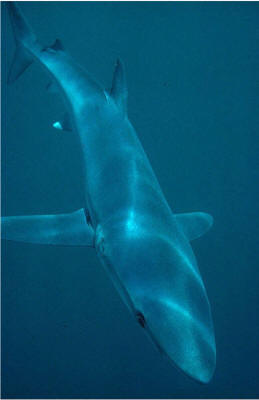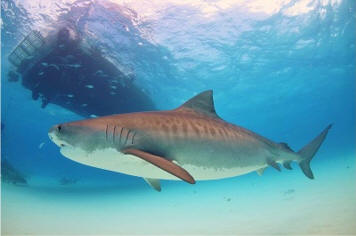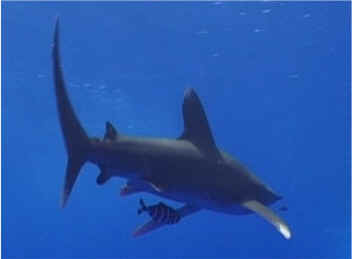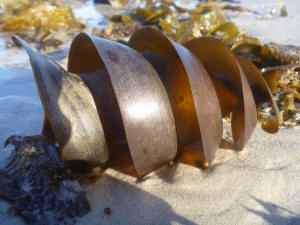TYPES OF SHARKS
To wrap it up, let's look at some of the types of sharks we've been discussing.
 ANGEL SHARK:
ANGEL SHARK:
- flat body like a stingray -- you can tell the shark is not a ray because the pectoral fins are not attached to the head.
- They bury themselves in the sand or mud with only the eyes and part of the top of the body exposed.
- They are bottom feeders, eating crustaceans like clams and mollusks and fish that are swimming close to the ocean floor
 BASKING SHARK:
BASKING SHARK:
- second largest shark (about 30 feet long and 8,000 pounds)
- filters plankton from the water using "gill rakers"
 BLACKTIP REEF SHARK (Carcharhinus melanopterus):
BLACKTIP REEF SHARK (Carcharhinus melanopterus):
- does well in captivity so is often found in aquariums (which is why we have so many photos of them)
- grey with a black tip on its fins and white streak on its side
 BLACKTIP
SHARK (Carcharhinus limbatus):
BLACKTIP
SHARK (Carcharhinus limbatus):
- Blacktip Sharks are different than Blacktip Reef Sharks (this confused me for quite some time)!
- They are usually about 5 feet long although the longest on record was about 9 feet long.
- during breeding season every February and March, around 10,000 congregate along the Florida coastline. It's like spring-break vacation for sharks!
 BLUE SHARK:
BLUE SHARK:
- about 12 feet long.
- sleek, tapered body
- among the fastest swimming sharks and can even leap out of the water
- diet consists mostly of squid, but it will eat almost anything
- considered dangerous - have attacked people
 BULL SHARK:
BULL SHARK:
- third most dangerous to people
- can swim in salt and fresh water and have even been found in the Mississipi river.
 COOKIECUTTER SHARK:
COOKIECUTTER SHARK:
- a small shark (less than 2 feet long)
- eats perfecty round chunks out of living whales and dolphins by clamping its teeth extremely sharp teeth onto them.
 GOBLIN SHARK
GOBLIN SHARK
- very uncommon and likely the strangest looking shark (rarely seen the photos were actually taken in 1909)
- pale, pinkish grey skin with a long pointed snout (it looks a bit like a sword on top of its head)
- lives in very deep water.
- found off the coast of Japan in 1898... until that time it was believed to have been extinct for 100 million years
 GREAT WHITE SHARK:
GREAT WHITE SHARK:
- more attacks on people than any other type.
- averages 12 feet long and 3,000 pounds.
- unlike most sharks, it can lift its head out of the water.
 HAMMERHEAD SHARK:
HAMMERHEAD SHARK:
- unlikely to attack people, but considered dangerous due to its predatory nature and its size (10 to 20 feet)
- eyes and nostrils are far apart, giving it a "hammerhead" appearance and allowing the shark to extend the range of its senses.
- their favorite food is stingrays. Luckily for the sharks, they're immune to the stingray's venom.
 MAKO SHARK:
MAKO SHARK:
- fastest swimmer (43 miles per hour)
- known to leap out of the water (sometimes into boats)

Nurse shark near Ambergris Caye, Belize -- photo by Joseph Thomas
NURSE SHARK:
- bottom dwelling shark
- thin, fleshy, whisker-like organs on the lower jaw in front of the nostrils that they use to touch and taste
- hunt at night, sleep by day
- common at aquariums

Port Jackson Shark, photo by Richard Ling, licensed under CC BY-SA 2.0
PORT JACKSON SHARK:
- nocturnal
- egg-laying
- one of nine living species of bullheaded sharks
- live near Port Jackson, Australia
They have very interesting spiral eggs that sometimes wash up on shore:

Sandtiger Shark, photo by Faris Algosaibi, licensed under CC BY-SA 2.0
SANDTIGER SHARK:
- the sandtiger shark has very pointed teeth -- the better to eat you with (if you're a fish!)
- 10 feet long
- predator (carnivore)
- nocturnal (hunts mostly at night)
- Babies: The mother shark has two uterus. Many sharks begin in the uterus, but the strongest one in each uterus eats all the others before they are born.
 SPINY DOGFISH SHARK:
SPINY DOGFISH SHARK:
- the most abundant shark
- 3 to 4 feet long
- slightly poisonous spines (not very harmful to people)
- used by people for food and research.
 THRESHER SHARK:
THRESHER SHARK:
- 10 foot tail (1/2 as long as the body) which it uses to herd small fish
 TIGER SHARK:
TIGER SHARK:
- second most attacks on people
- eat anything! (have been found with boat cushions and alarm clocks in their stomachs)
 WHALE SHARK:
WHALE SHARK:
- biggest shark and biggest fish
- it isn't a whale (whales are mammals, not fish)
- grow to 45 feet long and 30,000 pounds, but average about 25 feet long
- filters plankton from the water using "gill rakers"

Photo by Yvonne
WHITE TIP REEF SHARK:
- probably the most common shark encountered by divers and snorkelers on tropical reefs
- about 3 feet long on average though it can be as big as 6 feet.
- dark grey with a white tip on the first and sometimes on the second dorsal fin as well as the tail lobes
 WOBBEGONG SHARK:
WOBBEGONG SHARK:
- about 8 feet long, but virtually harmless.
- lives in Australia and Pacific coastal reefs
- lies on the bottom of the ocean waiting for fish to come near.
- filters food into its mouth with worm-like projections on its head
- razor-like teeth
- yellow, brown and gray camouflage colouring.
 ZEBRA SHARK:
ZEBRA SHARK:
- small, gentle shark that can be kept in an aquarium with other fish
- tail is half its length
< PREV NEXT >
